For vigils, protests, rallies, and teach-ins, first ask, "What are the objectives of the public demonstration?" Is it to make a demand and, if so, what is that demand?
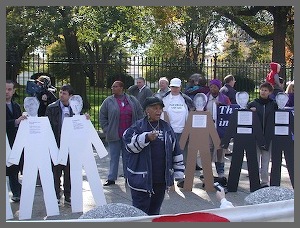
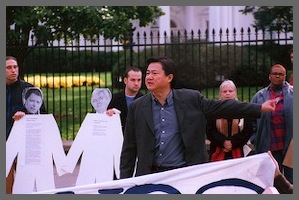
Carrie Graves, Sanho Tree, Journey for Justice: Washington, DC 2002
Logistical questions include: will you need a permit from the police or city hall? What type of visual aids (posters, banners, or costumes) do you plan to use? What flyers will you hand out, if any at all? How will you publicize your event?
Messengers and Message
To call for a public demonstration, organizers have two basic responsibilities: crafting a message for the public and assembling as many messengers of the message as you can.
Unlike a public meeting, a demonstration can reach a much wider audience of people, including supporters, opponents and, very likely, a large number of individuals who have limited, if any, knowledge of the message you are intending to spread.
In a public meeting, you are inviting the public to attend. A demonstration is different as there are people who'll hear the message because they're using the sidewalk or public place in their regular routine. Your message may be the first time a lot of people considered it.
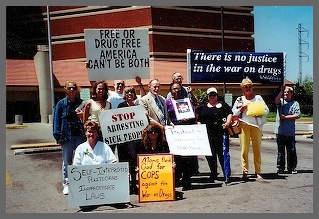
Mother's Day Protest: Oklahoma City, OK 2000
Printed material, flyers, and demonstration posters must express concise demands and/or educational objectives. Always remember to let interested people know what they can do to help. Remember to have local contact information on printed material that's given to the public.
Slogans should express the message simply and dramatically: 'Schools Not Prisons,' for example. 'There is no justice in the war on drugs' is short and to the point. Stop Drug War Injustice, another good one. Prisoner Abuse -- a national disgrace, etc. Stencils are an easy way to create lettering on a poster. Neat hand lettered posters are personal and effective, too. We all love to read handmade posters.
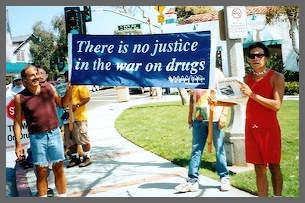
Rally Against the Drug War: Laguna Beach, CA 2000
If the group reaches consensus on messages, your overall message stays unified and focussed. Make posters together! Volunteers enjoy and need activities like this. Have everyone bring supplies and a snack to a meeting before the demonstration. Supply poster board, paint and brushes. Most people have some of these items around the house -- and will donate them to this purpose.
While you make posters, prepare short and easy-to-understand chants ahead of time, and when appropriate (not during silent vigils), keep the chants going throughout the demo. Chants (or lively songs) attract attention. People will take notice and want to know what is going on, in addition to making good background sounds for television or radio media. You may want to prepare for this and appoint a chant leader beforehand.
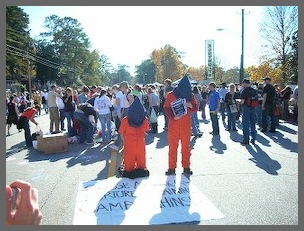
SOA Watch Rally: Ft. Benning, GA 2006
Public means visible
Lines of people holding signs bring automatic attention for sure, but there are many creative ways to get more attention to your gathering of demonstrators.
A demonstration must be visual, and can be much more than just a picket line of people holding signs. Consider eye-catching costumes, cages, street theater, or other creative means of your own design to get people interested in who you are and why you're there.
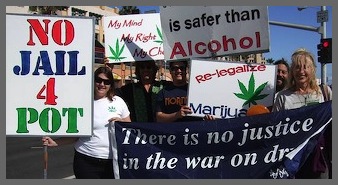
Rally Against the Drug War: Laguna Beach, CA 2007
When making posters, remember that large lettering, white or light color on dark background is most visible.
Use Current Events and Local Hooks
In Colville, Washington where the November Coalition office is a jail initiative put before voters gave us opportunity to have a demonstration march by joining the annual county fair parade, down Main Street, then up Oak, come along for fun, we have a short video that explains our action better than words can.
Know local regulations and get permission
Visit the demonstration site beforehand so you'll spark ideas for setting things up.
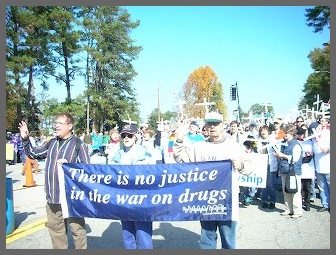
SOA Watch Rally: Ft. Benning, GA 2007
Permits can take weeks to get, and organizers need to know details far enough in advance to plan a detailed schedule. Permits are not usually required if you are going to use, but not block, a public sidewalk. Blocking a public sidewalk is never allowed. Overflowing into the street isn't either. Street marches need permits that require city planning. Please give the city clerk weeks of notice, and file this type of permit early.
Local Volunteer Katana Christen
Your group may choose to demonstrate on a regular basis. If so, try to get a renewable permit that will cover a span of time, rather than go through the permitting process each time you vigil, rally or demonstrate. Pick up several copies of the application to have on file. A city clerk should be able to answer questions that don't get answered by the information you get with the permit application. Just ask.
Selecting a date
If you are beginning to plan a large public demonstration, check the local community calendar carefully. Do not select a day and time that conflicts with other large events, unless your area is urban, and heavily populated with potential supporters. The event schedule can overshadow these priorities, however, but if you have a date range to choose from, check the local calendar.
Media coverage is easier to get when you stage the event during customary work hours on weekdays. Sometimes this is a trade-off; you're likely to be more challenged to find demonstration-participants during the workweek.
Notify the media
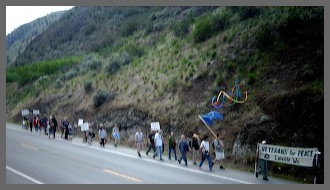
Annual Mothers Day Peace March, Oroville, WA 2007
Enjoy the demonstration!
Leader organizers should be on the site at least one-half hour before starting time, 15 minutes if it's a regular and short demonstration.
Keep your group together, and remind everyone (quietly) to hold their signs so they can be clearly seen and photographed. Write down the names and telephone numbers of people demonstrating because you'll contact them for future actions. A clipboard is handy for the organizer to carry, and it can designate the leader if any official wants to talk to someone in your group.
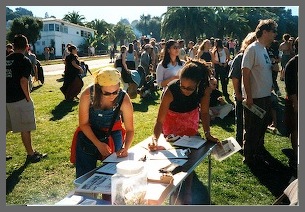
Prisoner Awareness Day: San Francisco, CA 1999
If TV news covers your vigil or demonstration, assign one person to tape each television station present at the event. Begin an archive of media coverage.
Be sure to pick up the newspaper to see how the event was described, and save this paper in your own archives. Send news footage tape and news articles to the main office of the November Coalition, and see your group featured later in the Razor Wire and the website.
